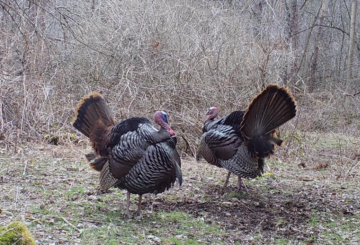“Wild turkeys face a dangerous world even before they hatch”
By Oak Duke
The month-long New York State spring gobbler season opens May 1, 2024 though a special two-day youth season happened April 20 and 21st.
And we wonder what it is going to be like this year?
Each year, since 1968 in Allegany County, May 1 has been the starting date for the gobbler season, when New York first opened a hunting season for toms.
The actual first New York State hunting season for turkey (either sex) began in Allegany County in 1959.
And there have been a lot of changes since then.
A glance at the harvest stats shows a peak around 1999 and 2001, where hunters tagged just shy of 45,000 birds in New York State.
What’s concerning is that the take figure in 2021 was 16,892 gobblers, that’s less than half of the turn of the century high, and was down 20% from 2020 and the prior 10-year average of 19,600.
The 10-year average from 1993 to 2003 was 38,400 toms.
New York State did react and cut back the Fall season, allowing just one bird per hunter instead of two, and chopped back the days from almost a month-long season to less than two weeks.
That had to help.
Reasons for the wild turkey population decline have experts scratching their heads across the country.
And of course everyone has an opinion and many an answer or two.
Kansas, facing a precipitous decline in its turkey population has actually cancelled its upcoming fall season until further notice.
And other states are modifying their seasons, facing similar turkey recruitment trends.
So New York is not alone is seeing a drop in turkey numbers.
Why?
The most popular answer is predators.

Wild turkeys face a dangerous world even before they hatch.
Skunks, raccoons, and opossums are notorious egg eaters.
Red fox, Gray fox, hawks and owls prey on the young poults, even if they find an adult turkey, especially a mature gobbler a bit intimidating.
I’ve seen hen turkey’s attack hawks that are hovering around her youngsters. And this spring, observed two jakes (young gobblers) actually attack, by flying at a Red-tailed hawk, perching on a low limb, studying them.

A list of predators would not be complete without mentioning some relative newcomers; coyotes, fishers, and bears.
Our coyote population in Western New York has seemed to stabilize, as they are very territorial and fight for hunting rights like their cousins the wolves.
But on a number of occasions I have had coyotes sneak into my turkey decoys while I was hunting. I have some good video footage of one, and another came in so close and quietly, I could have touched him, if I hadn’t jumped, I was so startled.
Of course bears have a super nose and can find a turkey nest if any animal can. They are in some wildlife studies the top predator of whitetail fawns.
And then we have the newest predator on the block, the fisher.
Fishers, like the wild turkey, have migrated into New York State from Pennsylvania and made themselves at home. They are everywhere now and lethal predators. Fishers can climb a tree and catch squirrels. So roosting turkeys asleep at night are easy pickings.
I have photos of fishers stalking my turkey decoys too.

But beyond predators (I don’t think Kansas has fishers or a viable population of Black bears,) climate change…whatever the cause or reason may have a greater impact on the wild turkey population than all the toothy critters put together.
Is our wild turkey population another “canary in the coal mine?” Being an apt metaphor for in this case…danger?
Wild turkeys seem to thrive best when they lay their eggs at just the right time.
That time was always during April and May here in New York State. As one travels south, turkeys lay their eggs earlier and therefore the spring gobbler seasons are earlier in the lower latitudes.
In Florida, gobbler season is in March. In Virginia, its April, and in West Virginia, it starts April 15.
The idea of a gobbler season is tied to the fact that toms breed hens and then have nothing to do with raising the youngsters.
So, if a gobbler or two is taken out of a woodlot, there are other gobblers to breed the hens.
And that management theory as regarding the toms has worked.
Spring turkey hunting season dates are constructed so most of the turkey breeding has been traditionally finished by the time of the opening date, depending on the state and the latitude.
But, our springtime is coming sooner.
And hen turkeys are laying their eggs sooner as they can’t read the calendar.
They go by what they feel, in large part ambient temperatures, along with photoperiodism and their internal clocks.
When early poults hatch, they awaken into a world with little vegetation… vacant of grasshoppers or bug life, so important for their protein and sustenance.
A late freeze can wipe them out.
But turkeys are resilient, and if an early egg clutch fails, they will lay another.
But late summer broods often show only a few little turkeys make it, as they are out of sync with the traditional unfolding of the seasons.

Oak Duke/Wellsville, NY/ April 2024
Facebook pages:
Whitetail Page: www.facebook.com/Oak.Duke.whitetail.page
Duke’s Honey: www.facebook.com/Dukes-Honey-513590015445371/







